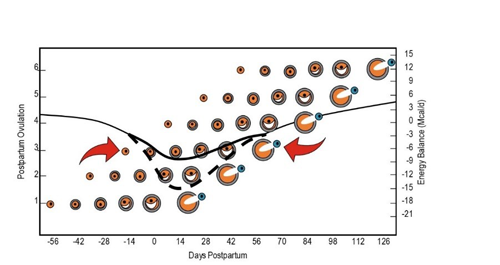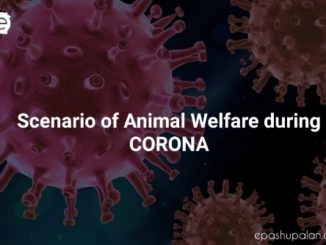Importance of Transition Management
The fate of transition management could be a critical thing about both the profitability and productivity in dairy herd. The standard and quantity of feed a cow eats is extremely important. The entire success of a transition phase depends on the dry matter intake of cow1. Cows that fail to transition successfully are easily exposed to several metabolic disorders throughout the lactation cycle. In the pre-fresh period, nutrient requirements have an opposite co-relation with the animals dry matter intake. Hence, ration nutrient concentration must be increased and minerals must be balanced1. The rumen must be prepared for next lactation diet which is rich in concentrate. Palatability is paramount during this period.
Setbacks during Transition Period
The pre-fresh cow could be a very selective eater on the farm. The forages within the ration must be fresh, consistent, uniform and mold-free2. The sweepings from the milking cows should not be used as a part of the pre-fresh ration. Total mixed ration (TMR) must be available at a minimum of once or twice per day. Never let the pre-fresh bunk remain empty during the day. Around 10-12% refusals are recommended3. Be careful to reduce and gradually introduce anionic salts, bypass fats, and animal proteins that aren’t very palatable. Include forages to be fed within the milking ration and within the pre-fresh ration to reduce adjustment after calving.
Care must be taken to ensure that the animals have enough immunity at the time of calving, else animals will be susceptible to hemo-protozoan diseases like theileriosis, babesiosis, etc. Immune dysfunction may lead to inflammation, which will delay the reinitiation of the ovarian function, follicle recruitment, ovulation and fertilization. Even maternal recognition of pregnancy and implantation occur against the backdrop of this metabolic and immunological disturbance in early lactation4. Hence, the role of nutrition in ensuring a smooth transition between the pregnant and lactating state is vital.
Way to Quantify an Effective Transition
Demonstrating the return on investment is difficult for feeding a transition cow on daily basis. But the results of an effective transition will be reflected on the next lactation cycle. Also, decrease in metabolic problems due to an improved mineral balance during the transition phase is a profit for the producer/ farmer. Furthermore, clinical and sub-clinical ketosis can be reduced to a greater extent. This is accomplished by increasing dietary energy concentration5. Energy concentration of diet cannot be increased if a farmer had one dry group, because the far-off dry cows would get too fat5.
Often, ketosis will begin to develop before calving. Once the ketosis sets in, it is difficult to control the downhill slide into ketosis problems after calving, even with the best fresh cow ration6. Finally, by regulating the rumen microbes with the help of transition diet, eliminating metabolic problems, intakes after calving can be increased. It takes a whole lot of time and effort to get the animal back to its peak milking once it experiences any or all the metabolic disorders.
Treatment cost for metritis/ retention of fetal membranes could be huge that the farmer may not be able to demonstrate any income from the milking cows. In countries like India, a dairy farmer bears on an average INR 1500-2000 treatment cost per animal due to these complications.
Standard operating procedures (SOP) must be established for each phase/ stage of the animal life cycle, so that the results can be measurable. These SOP can be helpful to assess the dairy manager performance as well as the animal performance during different stages of life. Flow charts on protocols must be followed and made available for all the metabolic disorders, to ensure that the veterinary staff doesn’t deviate from the SOP, especially during the calving time.
Can a same ration work for far off as well as close up cows?
Transition cows are considered future “money makers” in the dairy farm, because it generates a cash flow in the 21 days after calving. Choices must be made very carefully when feeding these cows as nutrition plays a major role during this turnover period. Feeding along with comfort are two essential things for a transition cow and must be specific to the group as it will make the cows prepare for the lactation phase.
Lactation Differences Between Cows Milk Yield
The best solution for any successful lactation is providing the right nutrition to the transition cows. Feeding a low potassium diet with appropriate amounts of anionic salts can reduce the chances of developing clinical and subclinical milk fever. Check the urine pH to predict the calcium status of cows at calving and monitor the effectiveness of an anionic ration. Provide enough forage to fill the rumen and encourage cud chewing. Maintain the diet of cows eating before calving. To minimize the competition, animals must have adequate space and ensure no crowding. If the cows get special ration despite of the lack of space, the ration will not be able to perform.
Importance of Amino Acids during Transition and Fresh Group
The calf growing inside the cow needs protein for muscle growth. Without adequate dietary protein before calving, the cow lacks protein reserves after calving which negatively impact the milk protein production1. Specific amino acids like methionine is required to clear the liver with accumulating fat. Proteins are also important in absorbing calcium, reducing sub-clinical milk fever and increasing dry matter intake1. Amino acid supplementation with methionine can be of great advantage during transition period. Osorio., et. al. demonstrated that dietary Rumen Protected Methionine(RPM) supplementation could expedite the synthesis of glutathione, an important antioxidant peptide and improve the antioxidant capacity of transition cows11.

Figure-1 shows the importance of essential amino acids at each stage of the embryo formation and attachment8,9,10
Energy Management for Pre-fresh Cow
The pre-fresh diets must contain about 1.54 MCal of Net Energy for lactation(NEL), which is ideal for both first calving heifers as well as cows12. Feeding forages/ feeds containing highly digestible fiber such as wheat hay/ paddy hay, soya hulls helps to meet the energy needs of the pre-fresh cow.
 Figure-2 shows the trend of ovarian follicles from Pre-partum to Post- partum7
Figure-2 shows the trend of ovarian follicles from Pre-partum to Post- partum7
The above picture represents the importance of energy management starting from pre-partum time. For the animal to show proper signs of heat, have a proper ovulation at post-partum and get conceived within first 90 days, the animal must always be in a positive state of energy11. The level of non-fiber carbohydrate (NFC) needs to be higher in pre-fresh diets, because the animal needs a higher concentration of energy12. Propionate, a volatile fatty acid (VFA) primarily produced from the fermentation of NFC, increases the length of the rumen papillae, which helps in increasing VFA absorptions after calving.12 Non-fiber carbohydrate levels help to transition the rumen microbes towards a lactating ration and helps to prevent the problems of the off feed and rumen acidosis, once the cow is supplemented with a lactating diet4. Supplemental protected niacin can help to aid the liver health and reduce the problem of acidosis6.
Conclusion
Transition from the dry period to lactation is a challenging period for dairy cattle because of many hormonal and metabolic changes that are taking place to support parturition and lactation. Transition period is also an investment phase and only with the help of a intelligent investment plan one can get better returns afterwards.
References
- Grummer, R. 1993. Feed to avoid fatty liver and ketosis. Hoard’s Dairyman, 754.
- 2014. Smartamine M and MetaSmart supplementation during the peripartal period alter hepatic expression of gene networks in 1-carbon metabolism, inflammation, oxidative stress, and the growth hormone-insulin-like growth factor 1 axis pathways. J. Dairy Sci., 97: 7451-7464.
- Drackley, J. K. Year. Nutritional management of dairy cows during the transition period.
- Sun, F., Cao, Y., Cai, C., Li, S. and Yu, C. 2016. Regulation of Nutritional Metabolism in Transition Dairy Cows: Energy Homeostasis and Health in Response to Post-Ruminal Choline and Methionine. PLOS ONE 11, (8): e0160659.
- Grummer, R. 1996. Make sure cows eat well before calving. Hoard’s Dairyman, 184.
- Mary Beth De Ondarza. 2004. Dry cow and Transition cow Nutrition.
- Britt, J. H. 1994. Follicular development and fertility: potential impacts of negative energy balance. In Proceedings of the National Reproduction Symposium, Pittsburgh, PA, USA. pp 103-112. Jordan E (ed) Texas A&M University.
- Ikeda, S., Sugimoto, M. and Kume, S. 2012. Importance of Methionine Metabolism in Morula-to-blastocyst Transition in Bovine Preimplantation Embryos. Journal of Reproduction and Development, 58(1), 91-97.
- Forde, N., Simintiras, C. A., Sturmey, R., Mamo, S., Kelly, A. K., Spencer, T. E., Bazer, F. W. and Lonergan, P. 2014. Amino acids in the uterine luminal fluid reflects the temporal changes in transporter expression in the endometrium and conceptus during early pregnancy in cattle. PLOS ONE, 9(6): p. e100010.
- Acosta, D., Denicol, A., Tribulo, P., Rivelli, M., Skenandore, C., Zhou, Z. and Cardoso, F. 2016. Effects of rumen-protected methionine and choline supplementation on the preimplantation embryo in Holstein cows. Theriogenology, 85(9):1669-1679.
- National Research Council. 1989. Nutrient Requirements for Dairy Cattle. 6th rev. ed. Update 1989. Natl.Acad. Sci., Washington, DC.
- Meghan Grone., Lauren Mayo., Derek Nolan. and Donna M. Amaral-Phillips. Proper Nutrition and Management of Transition Dairy Cows.Co-operative extension service. College of Agriculture, University of Kentuky.







Be the first to comment